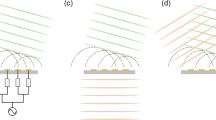Abstract
This paper investigates the performance of a compact space-time diversity receiver for mobile communication systems. Expressions for the bit error rate and outage meanSnr are derived as a function of the channel covariance matrix. These results define the sensitivity of the performance of such a receiver to the environment (fading characteristics and angular spread) and the antenna array (geometry and coupling). Furthermore, these results are validated for a practical antenna system.
Résumé
Dans cet article, les performances d’un récepteur compact fournissant une diversité d’espace et de trajet dans le contexte d’un systeme de communications mobiles sont étudiées. Les expressions de la probabilité d’erreur sur les bits et d’un rapport signal sur bruit moyen minimal sont déterminées en fonction de la matrice de covariance du canal. Ces résultats permettent d’évaluer la sensibilité des performances à l’environnement (caractéristiques des évanouissements, dispersion angulaire) et à l’antenne en réseau (géométrie et couplage). A titre d’illustration, des résultats expérimentaux montrent les performances d’une antenne en réseau particulière.
Similar content being viewed by others
References
Zoltowski (M. D.), Ramos (J.): Blind adaptive beamforming forCdma based PCS/cellular“,29th Asilomar Conference on Signals, Systems and computers, (November 1995).
Diouris (J. R.), Zeidler (J.): Performance analysis of a compact array receiver forCdma cellular communications,Proc. IEEE Military Communications Conference, pp. 182–186, (October 98).
Pierce (J.N.), Stein (S.): Multiple diversity with non-independent fading,Proceedings of the IRE, (1960).
Simon (M. K.), Alouini (M. H.): A unified approach to the performance analysis of digital communication over generalized fading channels,Proceeding of the IEEE, (November 98).
Iwai (H.), Buljore (S.), Zeidler (J. R.), Milstein (L. B.): Theoretical analysis of spatial and temporal dispersion of a propagation channel for combinedRake and phased array in mobileCdma systems,8th IEEE International Symposium on Personal Indoor and Mobile Radio Communications, pp. 514–518, (September 1997).
Krauss (J. D.): Antennas,Second edition, (1988).
Compton (R. T.): Adaptive antennas: concept and performance,Prentice-Hall, (1988).
Proakis (J. G.): Digital communications,McGraw-Hill, (1989).
Tsunekawa (K.) Kagoshima (K.):Correlation coefficients of diversity antennas on a small metal body, Proceeding of ISAP’89, pp. 585–588, (1989).
Buljore (S.), Diouris (J. R.), Zeidler (J.), Milstein (L.): Performance enhancements forDs-cdma receivers using space-path diversity,Proc. IEEE Military Communications Conference, pp. 1108–1112, Monterey, (Nov. 97).
Author information
Authors and Affiliations
Rights and permissions
About this article
Cite this article
Diouris, JF., Zeidler, J. & Buljore, S. Space-path diversity in cdma using a compact array. Ann. Télécommun. 53, 425–434 (1998). https://doi.org/10.1007/BF02998589
Received:
Issue Date:
DOI: https://doi.org/10.1007/BF02998589
Key words
- Mobile radiocommunication
- Code division multiple access
- Space diversity
- Antenna array
- Signal to noise ratio
- Error probability
- Covariance matrix
- Sensitivity
- Theoretical study
- Experimental result




